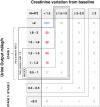Urine Output Monitoring for the Diagnosis of Early-Onset Acute Kidney Injury in Very Preterm Infants
- PMID: 35764392
- PMCID: PMC9269638
- DOI: 10.2215/CJN.15231121
Urine Output Monitoring for the Diagnosis of Early-Onset Acute Kidney Injury in Very Preterm Infants
Abstract
Background and objectives: The current threshold used for oliguria in the definition of neonatal AKI has been empirically defined as 1 ml/kg per hour. Urine output criteria are generally poorly documented, resulting in uncertainty in the most accurate threshold to identify AKI in very preterm infants with known tubular immaturity.
Design, setting, participants, & measurements: We conducted a bicentric study including 473 very preterm infants (240/7-296/7 weeks of gestation) born between January 2014 and December 2018 with urine output measurements every 3 hours during the first 7 days of life and two serum creatinine measurements during the first 10 days of life. AKI was defined using the neonatal Kidney Disease Improving Global Outcomes (KDIGO) definition. We tested whether higher urine output thresholds (1.5 or 2 ml/kg per hour) in modified AKI definitions may better discriminate neonatal mortality compared with the current definition.
Results: Early-onset AKI was developed by 101 of 473 (21%) very preterm infants. AKI was diagnosed on the basis of urine output criteria alone (no rise in creatinine) for 27 of 101 (27%) participants. Early-onset AKI was associated with higher risk of death before discharge (adjusted odds ratio, 3.9; 95% confidence interval, 1.9 to 7.8), and the AKI neonatal KDIGO score showed good discriminative performance for neonatal mortality, with an area under the receiver operating characteristic (ROC) curve of 0.68 (95% confidence interval, 0.61 to 0.75). Modified AKI definitions that included higher urine output thresholds showed significantly improved discriminative performance, with areas under the ROC curve of 0.73 (95% confidence interval, 0.66 to 0.80) for the 1.5-ml/kg per hour threshold and 0.75 (95% confidence interval, 0.68 to 0.81) for the 2-ml/kg per hour threshold.
Conclusions: Early-onset AKI was diagnosed on the basis of urine output exclusively for a quarter of the cases. Furthermore, modified AKI definitions that included higher urine output improved the discriminative performance for predicting mortality.
Keywords: acute kidney injury; early diagnosis; infant; mortality; neonatal KDIGO; preterm; tubular immaturity; urine output; very preterm.
Copyright © 2022 by the American Society of Nephrology.
Figures



Comment in
-
Urine or You're Out? Perspectives on Urinary Output Thresholds in the Neonatal Acute Kidney Injury Definition.Clin J Am Soc Nephrol. 2022 Jul;17(7):939-941. doi: 10.2215/CJN.06010522. Epub 2022 Jun 28. Clin J Am Soc Nephrol. 2022. PMID: 35764394 Free PMC article. No abstract available.
References
-
- Chawanpaiboon S, Vogel JP, Moller A-B, Lumbiganon P, Petzold M, Hogan D, Landoulsi S, Jampathong N, Kongwattanakul K, Laopaiboon M, Lewis C, Rattanakanokchai S, Teng DN, Thinkhamrop J, Watananirun K, Zhang J, Zhou W, Gülmezoglu AM: Global, regional, and national estimates of levels of preterm birth in 2014: A systematic review and modelling analysis. Lancet Glob Health 7: e37–e46, 2019 - PMC - PubMed
-
- Lee AC, Blencowe H, Lawn JE: Small babies, big numbers: Global estimates of preterm birth. Lancet Glob Health 7: e2–e3, 2019 - PubMed
-
- Brenner BM, Garcia DL, Anderson S: Glomeruli and blood pressure. Less of one, more the other? Am J Hypertens 1[4 Pt 1]: 335–347, 1988 - PubMed
-
- Selewski DT, Charlton JR, Jetton JG, Guillet R, Mhanna MJ, Askenazi DJ, Kent AL: Neonatal acute kidney injury. Pediatrics 136: e463–e473, 2015 - PubMed
Publication types
MeSH terms
Substances
LinkOut - more resources
Full Text Sources
Medical

